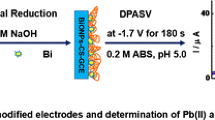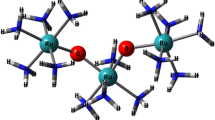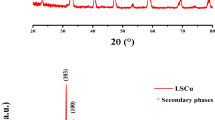Abstract
Great attention has been paid to the impact of heavy metals due to their abundance and presence in biological and environmental systems. Cr3+, among the heavy metals, employed for catalysts, leather tanning, glass, and paints is almost harmless. It is worth mentioning, Cr3+ has the major role in some metabolic processes. Therefore, there is a fundamental need to introduce a novel, efficient, selective, simple, and low-cost techniques for the determination of Cr3+. Herein, the poly (rutin)/carbon black-chitosan nanocomposite-modified glassy carbon electrode (PRu/CB-Chi/GCE) was employed as a selective sensor for Cr3+ electrochemical determination using differential pulse anodic stripping voltammetry (DPASV) technique. Cyclic voltammetry (CV), electrochemical impedance spectroscopy (EIS), differential pulse voltammetry (DPV), and field emission scanning electron microscopy (FESEM) were performed to investigate the electrodes. According to optimal conditions, the linear range was achieved between 0.05 nM and 2000 nM with the detection limit (LOD) (S/N = 3) obtained 0.016 nM. The modified electrode was found to indicate the qualities of repeatability, reproducibility, selectivity, and stability ability. To demonstrate the applicability of the sensor, the modified GCE was applied to detect chromium (III) ions in tap and river water samples with good recoveries of 91.54–103.17% – revealing that the sensor has suitable practicability toward Cr3+.
Graphical abstract











Similar content being viewed by others
References
Giakisikli G, Anthemidis AN (2013) Magnetic materials as sorbents for metal/metalloid preconcentration and/or separation. A review. Anal Chim Acta 789:1–6. https://doi.org/10.1016/j.aca.2013.04.021
Metters JP, Kadara RO, Banks CE (2012) Electroanalytical sensing of chromium (III) and (VI) utilising gold screen printed macro electrodes. Analyst 137:896–902. https://doi.org/10.1039/C2AN16054D
Bagherzadeh M, Hadizadeh Z, Akrami Z, Ghahfarokhi ZS (2021) Electrochemical detection of cr (III) and cr (VI) in solution by using ZrO2 modified magnetic nanoparticles by redox probes. Mater Sci Semiconduct Process 131:105840. https://doi.org/10.1016/j.mssp.2021.105840
Sadeghi S, Garmroodi A (2013) A highly sensitive and selective electrochemical sensor for determination of cr (VI) in the presence of cr (III) using modified multi-walled carbon nanotubes/quercetin screen-printed electrode. Mater Sci Eng C 33:4972–4977. https://doi.org/10.1016/j.msec.2013.08.020
McRae R, Bagchi P, Sumalekshmy S, Fahrni CJ (2009) In situ imaging of metals in cells and tissues. Chem Rev 109:4780–4827. https://doi.org/10.1021/cr900223a
Markiewicz B, Komorowicz I, Sajnóg A, Belter M, Barałkiewicz D (2015) Chromium and its speciation in water samples by HPLC/ICP-MS–technique establishing metrological traceability: a review since 2000. Talanta 132:814–828. https://doi.org/10.1016/j.talanta.2014.10.002
Zhang N, Suleiman JS, He M, Hu B (2008) Chromium (III)-imprinted silica gel for speciation analysis of chromium in environmental water samples with ICP-MS detection. Talanta 75:536–543. https://doi.org/10.1016/j.talanta.2007.11.059
Mondal BC, Das D, Das AK (2002) Synthesis and characterization of a new resin functionalized with 2-naphthol-3, 6-disulfonic acid and its application for the speciation of chromium in natural water. Talanta 56:145–152. https://doi.org/10.1016/S0039-9140(01)00558-6
Wu S, Sekar NC, Tan SN, Xie H, Ng SH (2016) Determination of chromium (III) by differential pulse stripping voltammetry at a chitosan–gold nanocomposite modified screen printed electrode. Anal Method 8:962–967. https://doi.org/10.1039/c5ay03291a
Mirzaei Karazan Z, Roushani M (2022) A new method for electrochemical determination of hippuric acid based on molecularly imprinted copolymer. Talanta 246:123491. https://doi.org/10.1016/j.talanta.2022.123491
Song Z, Ma Y, Morrin A, Ding C, Luo X (2021) Preparation and electrochemical sensing application of porous conducting polymers. TrAC Trends Anal Chem 135:116155. https://doi.org/10.1016/j.trac.2020.116155
Munonde TS, Nomngongo PN (2020) Nanocomposites for electrochemical sensors and their applications on the detection of trace metals in environmental water samples. Sens 21:131. https://doi.org/10.3390/s21010131
Yu H, Yan F, Dai Z, Ju H (2004) A disposable amperometric immunosensor for α-1-fetoprotein based on enzyme-labeled antibody/chitosan-membrane-modified screen-printed carbon electrode. Anal Biochem 331:98–105. https://doi.org/10.1016/j.ab.2004.03.042
Ngah WW, Kamari A, Fatinathan S, Ng PW (2006) Adsorption of chromium from aqueous solution using chitosan beads. Adsorption 12:249–257. https://doi.org/10.1007/s10450-006-0501-0
Mirzaei Karazan Z, Roushani M (2023) Selective determination of cadmium and lead ions in different food samples by poly (Riboflavin)/carbon black-modified glassy carbon electrode. Food Chem 423:136283. https://doi.org/10.1016/j.foodchem.2023.136283
Karabiberoğlu ŞU, Koçak ÇC, Dursun Z (2019) An over-oxidized poly (Rutin) modified electrode for selective and sensitive determination of catechol and hydroquinone. Electroanal Chem 850:113415. https://doi.org/10.1016/j.jelechem.2019.113415
Manikandan R, Deepa PN, Narayanan SS (2017) Fabrication and characterization of poly 2-napthol orange film modified electrode and its application to selective detection of dopamine. J Solid State Electrochem 21:3567-78–3578. https://doi.org/10.1007/s10008-017-3604-5
Dai H, Wang N, Wang D, Zhang X, Ma H, Lin M (2016) Voltammetric uric acid sensor based on a glassy carbon electrode modified with a nanocomposite consisting of polytetraphenylporphyrin, polypyrrole, and graphene oxide. Microchim Acta 183:3053–3059. https://doi.org/10.1007/s00604-016-1953-x
Cosnier S, Karyakin A (2011) Electropolymerization: concepts, materials and applications. Mater Sci. https://doi.org/10.1002/9783527630592
Zhang Y, Li C, Su Y, Mu W, Han X (2020) Simultaneous detection of trace cd (II) and pb (II) by differential pulse anodic stripping voltammetry using a bismuth oxycarbide/nafion electrode. Inorg Chem Commun 111:107672. https://doi.org/10.1016/j.inoche.2019.107672
Aravind A, Sebastian M, Mathew B (2018) Green synthesized unmodified silver nanoparticles as a multi-sensor for cr (iii) ions. Environ Science: Water Res Technol 4:1531–1542. https://doi.org/10.1039/C8EW00374B
Ejeta SY, Imae T (2021) Selective colorimetric and electrochemical detections of cr (III) pollutant in water on 3-mercaptopropionic acid-functionalized gold plasmon nanoparticles. Anal Chim Acta 1152:338272. https://doi.org/10.1016/j.aca.2021.338272
Renedo OD, Lomillo MA, Martinez MA (2004) Optimisation procedure for the inhibitive determination of chromium (III) using an amperometric tyrosinase biosensor. Anal Chim Acta 521:215–221. https://doi.org/10.1016/j.aca.2004.06.026
El-Shishtawy RM, Rahman MM, Sheikh TA, Nadeem Arshad M, Al-Zahrani FA, Asiri AM (2020) A new Cr3+ electrochemical sensor based on ATNA/nafion/glassy carbon electrode. Mater 13:2695. https://doi.org/10.3390/ma13122695
Ghanbary E, Asiabani Z, Hosseini N, Kiaie SH, Kaki S, Ghasempour H, Babakhanian A (2020) The development of a new modified graphite pencil electrode for quantitative detection of gibberellic acid (GA3) herbal hormone. Microchem J 157:105005. https://doi.org/10.1016/j.microc.2020.105005
Abolghasemi MM, Ghorbani-Cheghamarani A, Babakhanian A (2017) A novel electrochemical sensing platform based on Pt/PPy/Eosin-Y for the determination of cadmium. New J Chem 41:11335–11341. https://doi.org/10.1039/C7NJ02080E
Azizi Z, Babakhanian A (2018) Fabricating a new electrochemically modified pencil graphite electrode based on acetophenone (2, 4-dinitrophenyl) hydrazone for determining selenium in food and water samples. Anal Methods 10:5205–5213. https://doi.org/10.1039/C8AY01959B
Sadeghi E, Rahimi F, Azizi Z, Kaki S, Babakhanian A (2023) Fabrication of a sensitive electrochemical sensor based on hybrid polyamide/chromotropic acid nanofibers electrospun on glassy carbon electrode for Hg2+ sensing in drinking water and canned fish samples. Food chem 414:135467. https://doi.org/10.1016/j.foodchem.2023.135467
Acknowledgements
This study has been supported by Ilam University.
Author information
Authors and Affiliations
Contributions
RRT: Resources, Investigation, Writing original draft, Data curation. MR: Supervision, Conceptualization, Methodology, Validation, Funding acquisition, Writing—review & editing. ZMK: Advisor, Resources, Investigation, Writing original draft, Data curation.
Corresponding author
Ethics declarations
Conflict of interest
The authors declare no potential conflict of interest.
Additional information
Publisher’s Note
Springer Nature remains neutral with regard to jurisdictional claims in published maps and institutional affiliations.
Rights and permissions
Springer Nature or its licensor (e.g. a society or other partner) holds exclusive rights to this article under a publishing agreement with the author(s) or other rightsholder(s); author self-archiving of the accepted manuscript version of this article is solely governed by the terms of such publishing agreement and applicable law.
About this article
Cite this article
Taresh, R.R., Roushani, M. & Karazan, Z.M. Selective electrochemical detection of chromium ions in water samples by poly (rutin)/carbon black-chitosan nanocomposite-modified glassy carbon electrode. J Appl Electrochem (2024). https://doi.org/10.1007/s10800-023-02054-z
Received:
Accepted:
Published:
DOI: https://doi.org/10.1007/s10800-023-02054-z




